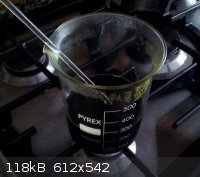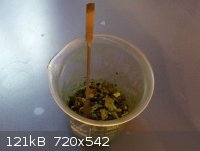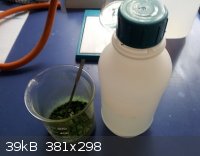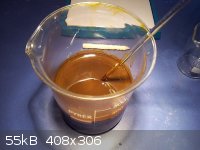| Pages:
1
2
3
..
5 |
Salmo
Harmless

Posts: 42
Registered: 20-9-2012
Member Is Offline
Mood: No Mood
|
|
Sodium Chromate from stainless stell 18/10
Hello to all, i know that there are other threads about this topic i studied them very well, but they are not exhaustive.
I'm trying to produce sodium chromate from stainless steel 18/10 with only OTC products.
I started dissolving 2 small ss spoons (28.8g) in 33% HCl (500ml?), it took a lot of time and it produced an horrible smell (i hate HCl), anyway they
completely dissolved and after that i evaporated the dark green solution to a green, almost dry, mass.
What i want to do now is to precipitate,with naoh, iron/chromium/nickel as hydroxides, wash them with water to get rid of all the NaCl, and then react
the solution, until fizzing stops, with some hydrogen peroxide (35%) and NaOH (again),to form Fe(OH)3 and sodium chromate , after that i want to
filter the solution to obtain a yellow liquid that should be sodium chromate plus some sodium hydroxide. So i would purificate my sodium chromate by
crystallization.
Am I correct ?Is this possible??would I really obtain Cr(OH)3 first or maybe something like sodium chromite that would be lost with filtration?
Please help me with this procedure, I promise that I will go on taking photos and posting them for every step that I will do.


|
|
|
elementcollector1
International Hazard
    
Posts: 2684
Registered: 28-12-2011
Location: The Known Universe
Member Is Offline
Mood: Molten
|
|
If the NaOH is strong enough, H2O2 isn't needed - the chromium will redissolve on its own to yield a lemon yellow solution of sodium chromate. Boil
this down (being careful of the fumes), and you have your NaCrO4, which can be purified with recrystallization if necessary.
What do you plan to use your chromate for?
Elements Collected:52/87
Latest Acquired: Cl
Next in Line: Nd
|
|
|
plante1999
International Hazard
    
Posts: 1936
Registered: 27-12-2010
Member Is Offline
Mood: Mad as a hatter
|
|
I'm the one who made this process and I have perfected it overtime. I still recommend to use molten sodium hydroxide mixed with sodium nitrate for the
chromium extraction from the dry mass, ''drano'' already contain a mix of sodium hydroxide and sodium nitrate and is perfectly suited for the purpose.
Then leach the dry residue with water to get sodium chromate solution. Do you absolutely want sodium chromate or ammonium/potassium dichromate would
be good for you?
I never asked for this.
|
|
|
blogfast25
International Hazard
    
Posts: 10562
Registered: 3-2-2008
Location: Neverland
Member Is Offline
Mood: No Mood
|
|
Plante:
Molten NaOH is dangerous overkill, as far as I'm concerned. Treat the mixed alkaline hydroxides with H2O2, then leach with strong NaOH (or KOH), the
leachate contains the yellow chromate (CrO4(2-)). Simmer to destroy excess peroxide.
I used to do it with a kind of 'wet fusion' but found it isn't necessary.
[Edited on 26-9-2012 by blogfast25]
|
|
|
plante1999
International Hazard
    
Posts: 1936
Registered: 27-12-2010
Member Is Offline
Mood: Mad as a hatter
|
|
Maybe 30% H2O2 Is dirty cheap for you but It isn't for me so I will stick with the molted NaOH method, in bonus of being cheap alkali fusion is a
robust process without hassle. I perfected it by the precipitation of the chromate as Potassium/ ammonium dichromate, potassium is better for the job.
I also used electrolysis of S.S in a carbonate electrolite but I found it energy intensive and take time to make some chromate but Hasslefree.
I never asked for this.
|
|
|
Salmo
Harmless

Posts: 42
Registered: 20-9-2012
Member Is Offline
Mood: No Mood
|
|
Plante: your method is surely good but i dont want to play with molten naoh at the moment.
Anyway i want to use only otc products so i koh is off limits, maybe ammonium chromate could be ok too.
Blogfast: thank you man but i have some questions for you.. First should i wash the hydroxides to remove the nacl and then add some naoh? I mean
before the addition of h2o2?
Second..I cant understand why leaching with naoh, maybe i dont understand, do you mean to first filter off and then wash the precipitate with strong
naoh solution? If yes please explain me.
|
|
|
triplepoint
Hazard to Others
  
Posts: 127
Registered: 11-4-2012
Location: U.S.
Member Is Offline
Mood: in equilibrium
|
|
KOH is OTC. it is used in soap making, among other things.
|
|
|
weiming1998
National Hazard
   
Posts: 616
Registered: 13-1-2012
Location: Western Australia
Member Is Offline
Mood: Amphoteric
|
|
Combining the mixed chromium and iron hydroxides with calcium hypochlorite (pool chlorine) and water, heating slightly, then filtering gives a
solution of very soluble calcium chloride and the much less soluble, bright yellow, solution of calcium chromate, which can be processed into
potassium dichromate (or any alkali metal/ammonium chromates/dichromates) through double displacement reaction with an alkali metal/ammonium sulfate
salt.
The solution can come out purple. This is due to the formation of ferrates. Just add some household ammonia until the purple disappears and filter
solution. Chromates are not strong enough oxidisers to oxidise ammonia, but ferrates will oxidize it to N2. This also destroys excess hypochlorite,
which will be eliminated as chloramines and a precipitate of Ca(OH)2.
Another way that is similar to this is to use liquid chlorine (concentrated NaClO(aq), not Cl2(l)!) or ordinary bleach to oxidize the chromium
hydroxides directly to sodium chromate. Most impurities can be eliminated by crystallizing them out since they aren't very soluble compared to sodium
chromate.
[Edited on 27-9-2012 by weiming1998]
|
|
|
bbartlog
International Hazard
    
Posts: 1139
Registered: 27-8-2009
Location: Unmoored in time
Member Is Offline
Mood: No Mood
|
|
I don't think so. What exactly is OTC varies from place to place - but if you have to order it over the internet, it doesn't qualify. Dudadiesel or
soapgoods.com no doubt have it, but if you can't get it from a local store... that's not OTC.
The less you bet, the more you lose when you win.
|
|
|
plante1999
International Hazard
    
Posts: 1936
Registered: 27-12-2010
Member Is Offline
Mood: Mad as a hatter
|
|
Don't forget that if you want dichromates salts you need to pass CO2 gas in the chromate solution and then add a satured solution of potassium
chloride to your sodium chromate solution. Cool it down and filter precipitated potassium dichromate.
2Na2CrO4 + 2CO2 + H2O -) Na2Cr2O7 + 2NaHCO3
Sulphuric acid do the job too, but CO2 is cheaper and safer.
[Edited on 27-9-2012 by plante1999]
I never asked for this.
|
|
|
blogfast25
International Hazard
    
Posts: 10562
Registered: 3-2-2008
Location: Neverland
Member Is Offline
Mood: No Mood
|
|
Salmo:
What I do is really slightly different because my purpose is to separate the Cr from the Fe, not necessarily to actually prepare chromate or
dichromate salts.
I oxidise the ferrous/chromic chloride soup first with strong H2O2 (35 %), then add strong alkali (NaOH or KOH) which dissolves the Cr as chromate
(VI) and precipitates hydrated ferric oxide. Filtering leaves behind the Fe (and others). The yellow solution of chromate is then the starting point
for whatever you want to do.
For instance, acidify the solution and add more H2O2 (or alcohol) and the chromate is reduced back to Cr(III). This can be precipitated again with
Na2CO3 as Cr(OH)3.nH2O and isolated by filtering/washing. And from that chromites/chromates/dichromates can be easily prepared without any junk
accompanying them.
But plate’s method may be quicker if you’re really looking to make the chromate or dichromate of potassium or ammonium.
Re. KOH: in the age of ‘Biodiesel’, unless you’re living in Timbuktu, KOH is easy to get. The streets of eBay are paved with KOH sellers, all
pack sizes imaginable. So if bbart wants to use personalised definitions of OTC that’s his problem. AFAIC.
|
|
|
Salmo
Harmless

Posts: 42
Registered: 20-9-2012
Member Is Offline
Mood: No Mood
|
|
weiming your method is interesting but i haven't calcium hypochlorite,i will search it in some hardwarestores maybe i could try with simple bleach i
will think about it.
plante thank you for the info  you are right CO2 is much better, and cheaper too. you are right CO2 is much better, and cheaper too.
blogfast you are helping me a lot but please tell me if i'm right..
H2O2 oxides FeCl2 and CrCl3 to ferric oxide and chromic oxide? is it chromium VI?
NaOH reacts with ferric oxide and chromic oxide to form ferric hydroxide (precipitate) and sodium chromate?(what's the reaction?)
Maybe I understood what you mean, you mean that first H2O2 reacts with iron (II) chloride forming iron (III) chloride then you add NaOH, you do
that to avoid the coprecipitation of iron and chromium a basic complex!
Now i have NaCl NaOH and sodium chromate in solution at the same time?
I like really much your way of purification, but when i will have only my almost pure Cr(OH)3 as a precipitate how could i obtain my sodium chromate
back ?
I'm stupid, I answer to myself: with stechiometric NaOH and H2O2 again 
[Edited on 27-9-2012 by Salmo]
[Edited on 27-9-2012 by Salmo]
[Edited on 27-9-2012 by Salmo]
|
|
|
bbartlog
International Hazard
    
Posts: 1139
Registered: 27-8-2009
Location: Unmoored in time
Member Is Offline
Mood: No Mood
|
|
Quote: Originally posted by blogfast25  | | ...The streets of eBay are paved with KOH sellers, all pack sizes imaginable. So if bbart wants to use personalised definitions of OTC that’s his
problem. AFAIC. |
I am being literal. OTC = Over The Counter; a term explicitly used to distinguish things that are available from some local brick & mortar shop
from those that can be had via mail order. Not only that, but in the reagents & apparatus acquisition thread there are plenty of examples of other
people using the term in the same way. For example, when a thread is titled 'OTC tert-Butanol', only two of the posters apparently use the term in the
way you suggest (as a synonym for 'easily ordered' I guess); the majority cleave to the older definition and discuss consumer goods that might or
might not be useful. While I wouldn't go so far as to say that *you* are the one with the personalized definition, I do think you are in the minority,
and IMO your usage obliterates a useful distinction.
The less you bet, the more you lose when you win.
|
|
|
blogfast25
International Hazard
    
Posts: 10562
Registered: 3-2-2008
Location: Neverland
Member Is Offline
Mood: No Mood
|
|
Salmo:
Ooops. Going back over my lab notes I found one glaring mistake in my description above: the oxidation of Cr(III) to Cr(IV) (chromate/dichromate) with
H2O2 only takes place in alkaline conditions. So the last time I separated Cr from Fe (from SS) I dissolved the SS in HCl first and filtered off any
acid insoluble residue. Then the ferrous/chromic chloride solution was neutralised to fairly strong alkaline conditions. Fe drops out as Fe(OH)2 and
Cr(OH)3 co-precipitates with it. Cool the slurry, then add peroxide slowly (35 or 9 %, both work – bleach should also work), this oxidises the Fe to
insoluble Fe(OH)3 and Cr to soluble chromate (CrO4(2-)). Simmer the slurry for a few minutes until effervescence stop, this kills any remaining H2O2
(this is important, as we will see)
Filtering yields a yellow solution containing the chromate. Acidify and you get the dichromate.
Important: in acid conditions dichromate oxidises H2O2 to O2, with the Cr being reduced back from Cr(VI) to green/blue Cr(III). So
unless you’re planning to reduce the Cr, you need to eliminate the excess hydrogen peroxide from the alkaline step. But if you’re planning to
reduce the Cr(VI) to (III) anyway there’s no need to eliminate the excess H2O2 from the first step.
Obtaining the Cr as acid soluble Cr(OH)3 has the advantage of being able to synth almost any simple Cr salt from it, including of course
chromates/dichromates.
Bbart: literalism is boring and context is everything. AFAIC, an eBay seller has a counter too: you order, pay and get your stuff, simples. And what
you can’t buy in a brick and mortar shop you’re unlikely to be able to buy on the Net.
|
|
|
Salmo
Harmless

Posts: 42
Registered: 20-9-2012
Member Is Offline
Mood: No Mood
|
|
oh my god  so today i made a big mistake.. i almost completely oxidized the
solution with H2O2 only,I added something like 200 ml and it goes on fizzing, have i to throw anything away ? Is possible that with hydrogen peroxide
i oxidized only the iron to iron oxide (maybe nickel too) and that the chromium is still chromium (III) chloride? What can I do now? Could I filter
off the iron oxide? and than add NaOH and repeat the oxidation with the new almost iron free solution?? so today i made a big mistake.. i almost completely oxidized the
solution with H2O2 only,I added something like 200 ml and it goes on fizzing, have i to throw anything away ? Is possible that with hydrogen peroxide
i oxidized only the iron to iron oxide (maybe nickel too) and that the chromium is still chromium (III) chloride? What can I do now? Could I filter
off the iron oxide? and than add NaOH and repeat the oxidation with the new almost iron free solution??
 
|
|
|
blogfast25
International Hazard
    
Posts: 10562
Registered: 3-2-2008
Location: Neverland
Member Is Offline
Mood: No Mood
|
|
Salmo:
No, don’t throw anything away. You’ve oxidised the Fe(II) to Fe(OH)3 which has precipitated (your solution was quite concentrated, not acidic
enough and that caused the Fe to drop out as hydroxide). Your Cr has in all likelihood co-precipitated as Cr(III) (it tends to do that).
Now neutralise the slurry to about pH 10 – 11 and the chill it to remove neutralisation heat. If there is excess H2O2 present that might be enough
to oxidise the Cr to chromate but to be on the safe side add some more H2O2, SLOWLY. The fizzing you observed before is oxygen and it means you’re
wasting H2O2. In alkaline conditions the half reaction (reduction) of H2O2 is:
H2O2(aq) + 2 e- == > 2 OH- (aq), so no O2 in sight.
Then try and filter the slurry (depending on thickness, you might want to add some water first). The filtrate should contain the Cr as yellow
chromate. You can test for it with a lead (II) salt: yellow PbCrO4 should precipitate.
|
|
|
Salmo
Harmless

Posts: 42
Registered: 20-9-2012
Member Is Offline
Mood: No Mood
|
|
Thank you blogfast, maybe you're right but it's strange i mean: If my Fe(II) has been oxidized to Fe(OH)3 where are my chloride ions Cl-? anyway maybe
It's just Fe(III) chloride but if so why is my solution so thick? Is some kind of peptization possible?
Ok I will follow you and I wont throw away anything 
I will alkalize first than add h2o2, then filtrate to get the yellow solution, than (as you told me before) i will add acid (h2so4 is ok?) more h2o2
to get Cr(III) back, sodium carbonate to precipitate it and than i will wash it really well!
Then, i will have almost pure Cr(III) hydroxide as [Cr(H20)3(OH)3] i will add the right amount of a NaOH solution (KOH should be better) until it's
fully dissolved than H2O2 again to get Cr(VI) as sodium chromate than finally crystallization. 
|
|
|
Mildronate
Hazard to Others
  
Posts: 428
Registered: 12-9-2009
Member Is Offline
Mood: Ruido sintetico
|
|
My eyes burn. Resource spending, stainless steel is more valuable
|
|
|
blogfast25
International Hazard
    
Posts: 10562
Registered: 3-2-2008
Location: Neverland
Member Is Offline
Mood: No Mood
|
|
Salmo:
Your chloride ions are spectator ions: they don't take part in the reactions and are found in the solution part of the slurry.
Not if it's scrap it ain't. Salmo and others aren't trying to recover Cr from SS industrially, it really is just a bit of educational fun, as
far as I'm concerned.
|
|
|
Endimion17
International Hazard
    
Posts: 1468
Registered: 17-7-2011
Location: shores of a solar sea
Member Is Offline
Mood: speeding through time at the rate of 1 second per second
|
|
Isn't chromium just an extremely tiny layer on stainless steel? Steel used for utensils and pots is usually iron-nickel alloy plated with chromium. It
would take an awful lot of utensils to get small amounts of chromate salt...
I agree, if it's educational fun, go for it, but such chromate would be very expensive.
|
|
|
plante1999
International Hazard
    
Posts: 1936
Registered: 27-12-2010
Member Is Offline
Mood: Mad as a hatter
|
|
In fact S.S is S.S because of chromium, even cheapest S.S contain 18% chromium and iron without any other metal. Quality S.S contain 18% Chromium 15%
nickel and iron. With dollar store spoon ( 18% chromium no nickel) it is not that costly. And with scrap it worth the cost to try my procedure.
I never asked for this.
|
|
|
Salmo
Harmless

Posts: 42
Registered: 20-9-2012
Member Is Offline
Mood: No Mood
|
|
blogfast you say that Cl- ions are spectator ions, but if they are so, which are theyr plus charged counterparts?
In a solution this equation must be always true.
a[A+]+b[B+]+...= c[C-]+d[D-]+...
Anyway mildronate if you think that scrap stainless steel is more valuable than what i'm trying to do, you dont understand how much is possible to
learn just with a spoon and some cheap OTC chemicals.
|
|
|
Endimion17
International Hazard
    
Posts: 1468
Registered: 17-7-2011
Location: shores of a solar sea
Member Is Offline
Mood: speeding through time at the rate of 1 second per second
|
|
Oh, so you mean not plated, but fully stainless steel? Because there are utensils that are plated only. They're cheaper.
Yeah, that might be very interesting, if we're talking about scrap.
|
|
|
blogfast25
International Hazard
    
Posts: 10562
Registered: 3-2-2008
Location: Neverland
Member Is Offline
Mood: No Mood
|
|
Quote: Originally posted by Salmo  | blogfast you say that Cl- ions are spectator ions, but if they are so, which are theyr plus charged counterparts?
In a solution this equation must be always true.
a[A+]+b[B+]+...= c[C-]+d[D-]+...
|
Ok. Let’s take the case of the oxidation and subsequent hydrolysis of FeCl2 to Fe(OH)3. Here are the balanced reactions:
1) Oxidation of the FeCl2 with peroxide:
FeCl2 === > Fe3+ + 2 Cl- + e-
½ x [H2O2 + 2 H+ + 2 e- === > 2 H2O]
Add up:
FeCl2 + ½ H2O2 + H+ === > Fe3+ + 2Cl- + H2O……. Eq.1
2) Subsequent hydrolysis of Fe3+:
Fe3+ + 3 H2O === > Fe(OH)3 + 3 H+……. Eq.2
3) Now add Eq.1 to Eq.2, scrapping redundant terms:
FeCl2 + ½ H2O2 + 2 H2O === > Fe(OH)3 + 2 HCl
(of course also: HCl + H2O === > H3O+ + Cl-)
Perfectly neutral, mon cher. Please note that above reaction equations represent stoichiometry (mass and electrical balances), not molecular reality!
I could have written these reactions w/o even mentioning Cl and they would still have been correct: hence the term 'spectator ion'.
[Edited on 29-9-2012 by blogfast25]
|
|
|
Salmo
Harmless

Posts: 42
Registered: 20-9-2012
Member Is Offline
Mood: No Mood
|
|
Damn you are right man I didnt thought about the "acidity" of FeCl3! I also found this on wikipedia:
| Quote: |
In industrial application, iron(III) chloride is used in sewage treatment and drinking water production.[13] In this application, FeCl3 in slightly
basic water reacts with the hydroxide ion to form a floc of iron(III) hydroxide, or more precisely formulated as FeO(OH)-, that can remove suspended
materials [Fe(H2O)6]3+ + 4 HO− → [Fe(H2O)2(HO)4]− + 4 H2O → [Fe(H2O)O(HO)2]− + 6 H2O
|
Anyway today i tryed to add NaOH to the slurry but it was impossible to understand what was happening in that solution..It was thick impossible to
check the pH, i adedd more H2O2 and i tryed to filter what i could.. and it was impossible too believe me.
I will try again next week starting from other spoons and I will first precipitate everything (with NaOH) and than add H2O2 , for who
wants to try too, remember never do the opposite  or a fucking brown colloidal
shit will form. or a fucking brown colloidal
shit will form.
[Edited on 29-9-2012 by Salmo]
|
|
|
| Pages:
1
2
3
..
5 |